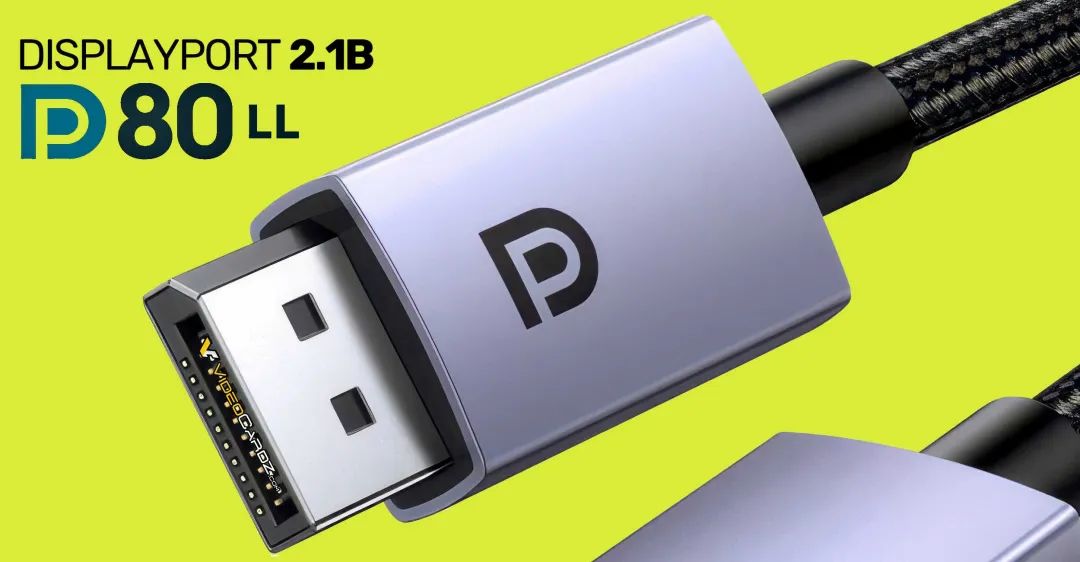At CES 2025, the Video Electronics Standards Association (VESA) unveiled the DisplayPort 2.1b standard, a refinement of its predecessor that prioritizes practicality over radical innovation. While the core specifications—such as the 80 Gbps maximum bandwidth—remain unchanged, the star of this update is the DP80LL (Low Loss) active cable, engineered to solve one of the most persistent challenges in high-speed connectivity: maintaining performance over extended distances.
This evolution addresses growing demands from gamers, content creators, and home theater enthusiasts who require flexible setups without sacrificing visual fidelity. By tripling the effective cable length while retaining blistering speeds, DisplayPort 2.1b bridges the gap between cutting-edge displays and real-world usability. Let’s explore how this update redefines connectivity for the next generation of digital experiences.

Key Features of DisplayPort 2.1b and DP80LL Cables
1. Extended Cable Length Without Compromise
The DP80LL cable supports reliable 3-meter transmissions, a significant leap from the 1-meter limit of passive DP80 cables. This extended reach empowers users to:
Connect high-refresh-rate gaming PCs to wall-mounted TVs in living rooms.
Arrange multi-monitor workstations in spacious office environments.
Integrate 8K projectors into home theaters without signal degradation.
2. Active Cable Design: The Secret to Stability
Unlike passive cables, DP80LL uses embedded signal amplifiers to counteract data loss over long distances. This active design ensures that the 80 Gbps bandwidth—delivered via Ultra High Bit Rate 20 (UHBR20) across four lanes—remains consistent, even at 3 meters.
3. Backward Compatibility and Forward-Thinking Flexibility
DisplayPort 2.1b maintains backward compatibility with older DisplayPort devices, though achieving 80 Gbps bandwidth requires updated GPUs and monitors. This balance ensures that early adopters can future-proof their setups while supporting legacy hardware.
Technical Breakdown: Why DP80LL Matters
Bandwidth Retention Meets Practical Innovation
While DisplayPort 2.1b doesn’t increase the 80 Gbps ceiling, it optimizes how that bandwidth is utilized. By minimizing signal loss, DP80LL cables unlock the full potential of existing specs:
8K@120Hz or 4K@240Hz gaming without compression artifacts.
Dual 8K displays for immersive multitasking in creative workflows.
Display Stream Compression (DSC) 1.2a support, enabling up to 97 Gbps for visually lossless streaming.
Signal Integrity: The Backbone of High-Fidelity Displays
Active components in DP80LL cables reduce attenuation (signal weakening) by up to 50% compared to passive alternatives. This stability is critical for:
High Dynamic Range (HDR) content, where subtle color gradients demand precision.
VR/AR headsets,rely on ultra-low latency for immersive experiences.
Color-critical tasks, such as video editing and medical imaging.
Industry Collaboration: Laying the Groundwork for Adoption
VESA developed DP80LL cables in partnership with leading tech firms like NVIDIA, which provided input on signal integrity for gaming and AI applications. However, current GPUs, including NVIDIA’s RTX 50-series, lack native DP2.1b support—a gap expected to close with next-gen architectures like Blackwell.

Applications and User Benefits
Gaming: Beyond the Desk
Gamers can now stretch their setups beyond traditional desk boundaries:
Ultra-wide monitors (e.g., 32:9 aspect ratio) paired with 4K@240Hz performance.
Long-distance VR setups, reducing clutter in play areas.
Multi-screen racing/flight simulators with zero lag between displays.
Professional Workflows: Powering Creativity
For designers, engineers, and video editors, DP80LL enables:
8K video editing with real-time rendering across dual monitors.
3D modeling on high-resolution displays with accurate color reproduction.
Financial dashboards spanning six or more screens for data analysis.
Home Entertainment: Cinematic Experiences Redefined
DP80LL transforms living rooms into high-tech hubs:
8K projectors streaming content from a centrally located PC.
Lossless audio/video passthrough to AV receivers and soundbars.
Future-proofing for emerging formats like 16K or holographic displays.
Challenges and Considerations
Hardware Adoption: A Waiting Game
While DP80LL cables will debut in spring 2025, widespread adoption hinges on:
GPU manufacturers integrating DP2.1b ports into next-gen products.
Monitor brands certifying displays for UHBR20 compatibility.
Cost vs. Performance
Active cables are pricier than passive ones—early estimates suggest DP80LL will cost 2–3x more than standard DP80 cables. However, the premium is justified for users needing long-range stability.
Competing Standards: HDMI 2.1’s Shadow
HDMI 2.2, expected in late 2025, promises similar bandwidth but targets a different audience:
HDMI dominates home theaters and consoles.
DisplayPort remains the go-to for PC gamers and professionals.
Future Outlook
Market Rollout and Beyond
Pre-certified DP80LL cables showcased at CES 2025 will hit shelves by mid-year, with widespread availability in 2026. VESA’s certification program ensures compliance, reducing buyer confusion.
AI and Adaptive Displays
Future iterations could leverage AI for:
Dynamic refresh rate adjustment based on content type.
Real-time HDR optimization for gaming and streaming.
Sustainability in High-Speed Tech
As demand grows, manufacturers face pressure to adopt eco-friendly materials and energy-efficient production methods without compromising performance.
Conclusion
DisplayPort 2.1b and its DP80LL cables represent a pragmatic yet transformative step for high-speed connectivity. By solving the “last-meter problem,” VESA empowers users to rethink how and where they deploy cutting-edge displays. While hardware adoption may lag initially, the standard lays a robust foundation for the next decade of gaming, creativity, and entertainment.
As CES 2025 prototypes evolve into retail-ready products, one truth becomes clear: In the race for pixel-perfect performance, flexibility is the new frontier.
Related Content
How to Convert HDMI to DisplayPort for Gaming, Work, and Beyond
HDMI 2.2 is coming! Major upgrade of HDMI standard
HDMI or DP: Which is Better for Gaming?
Tag:DisplayPort 2.1b




